Abstract
High levels of HDL-cholesterol (HDL-C) protect against coronary heart disease susceptibility, but the metabolic mechanisms underlying elevated HDL-C levels are poorly understood. We now report the turnover of isologous radioiodinated HDL apolipoproteins, apo A-I and apo A-II, in 15 female subjects on a metabolic diet with HDL-C levels ranging from 51 to 122 mg/dl. The metabolic parameters, fractional catabolic rate (FCR) and absolute synthetic rate (SR), were determined for apo A-I and apo A-II in all subjects. There was an inverse correlation between plasma HDL-C and the FCR of apo A-I and apo A-II (r = -0.75, P less than 0.001, and r = -0.54, P = 0.036, respectively), but no correlation with the SR of either apo A-I or apo A-II (r = 0.09, and r = -0.16, respectively, both P = NS). Apo A-I levels correlated inversely with apo A-I FCR (r = -0.64, P = 0.01) but not with apo A-I SR (r = 0.30, P = NS). In contrast, plasma levels of apo A-II did not correlate with apo A-II FCR (r = -0.38, P = 0.16), but did correlate with apo A-II SR (r = 0.65, P = 0.009). Further analysis showed that apo A-I and apo A-II FCR were inversely correlated with the HDL-C/apo A-I + A-II ratio (r = -0.69 and -0.61, P = 0.005 and 0.015, respectively). These data suggest that: (a) low HDL apolipoprotein FCR is the predominant metabolic mechanism of elevated HDL-C levels; (b) apo A-I FCR is the primary factor in controlling plasma apo A-I levels, but apo A-II SR is the primary factor controlling plasma apo A-II levels; (c) low HDL apolipoprotein FCR is associated with a lipid-rich HDL fraction. These findings elucidate aspects of HDL metabolism which contribute to high HDL-C levels and which may constitute mechanisms for protection against coronary heart disease.
Full text
PDF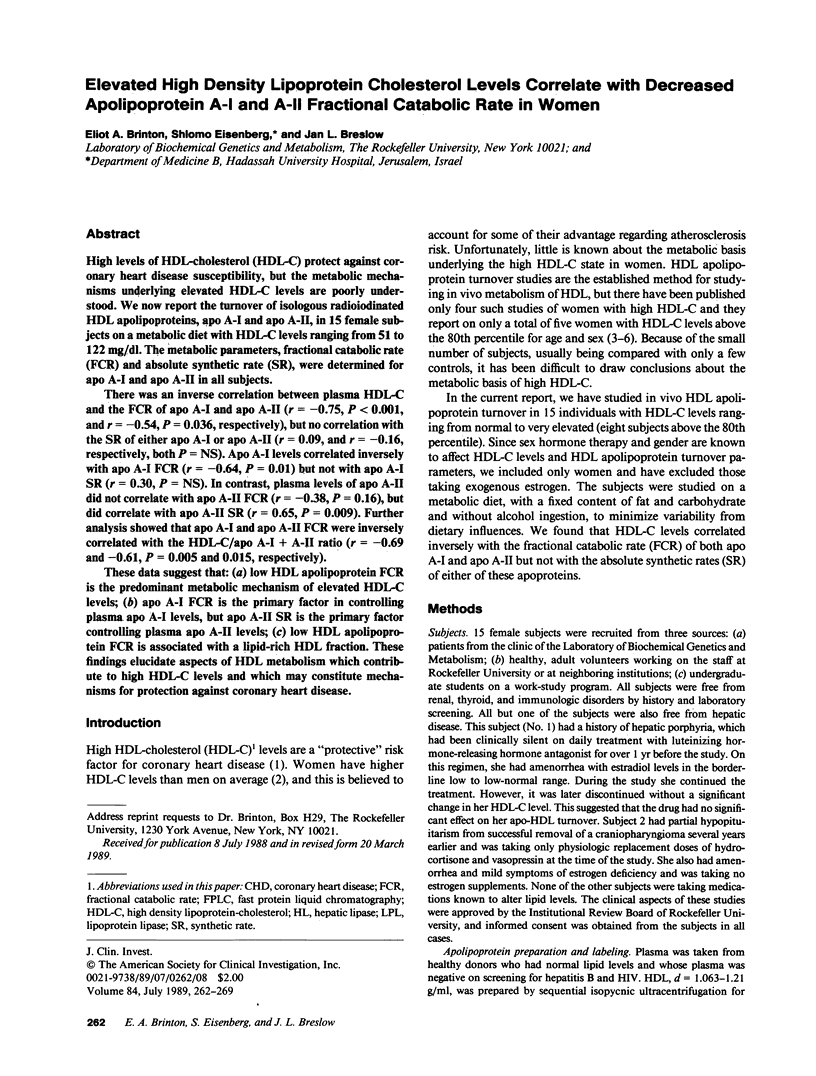
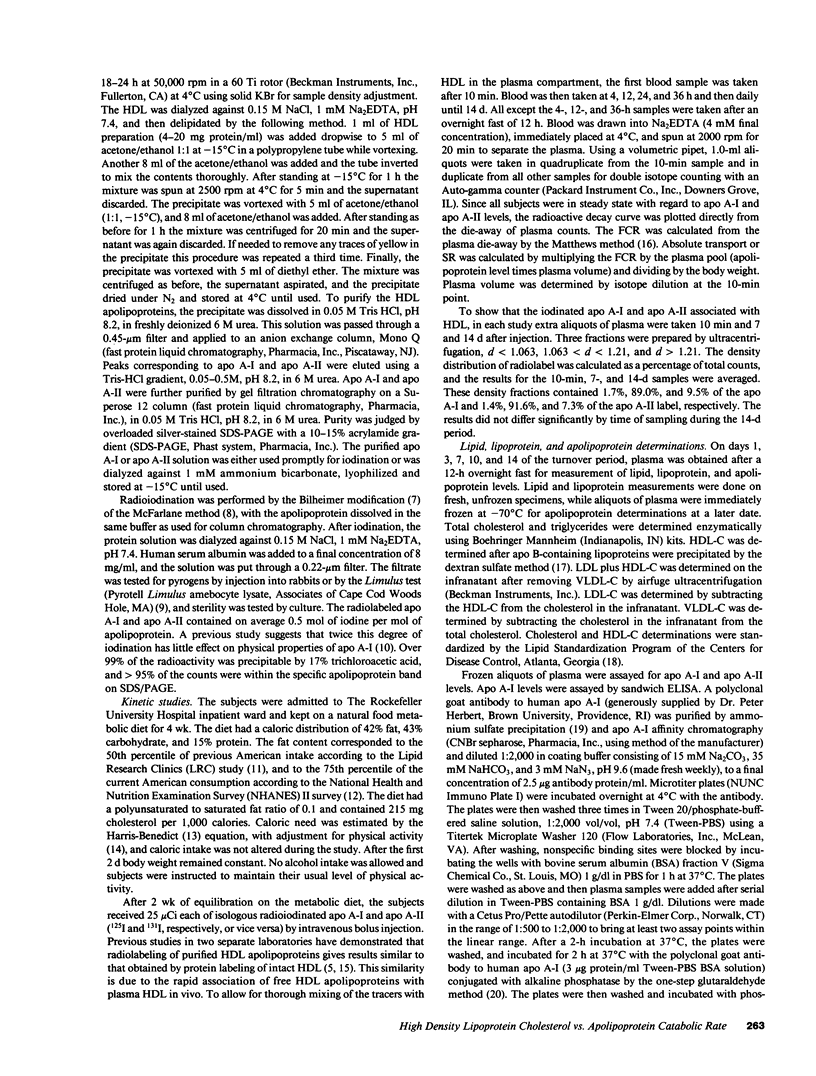
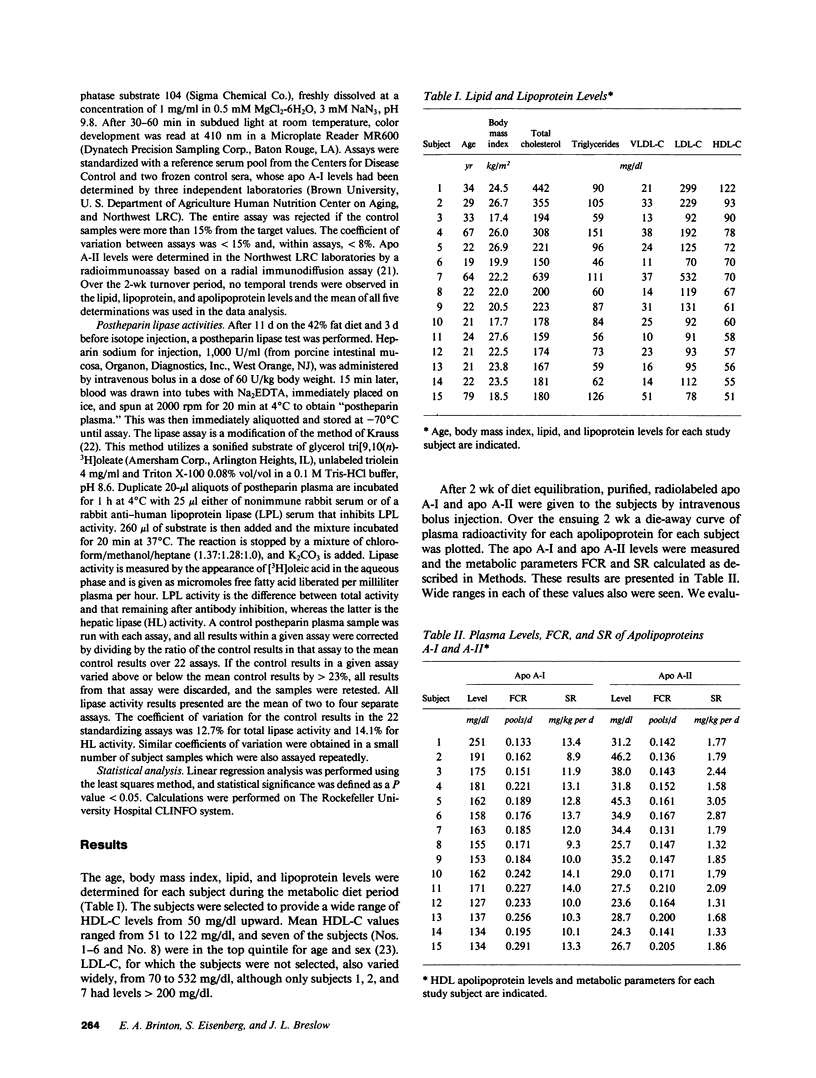
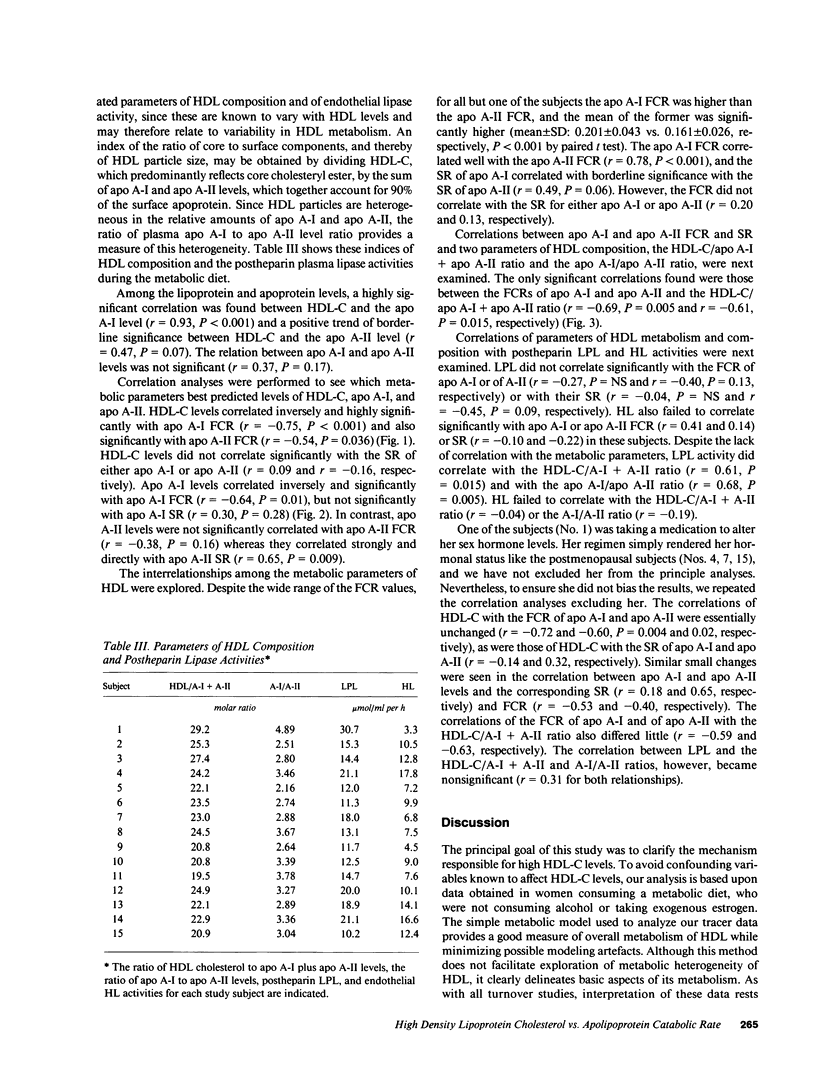
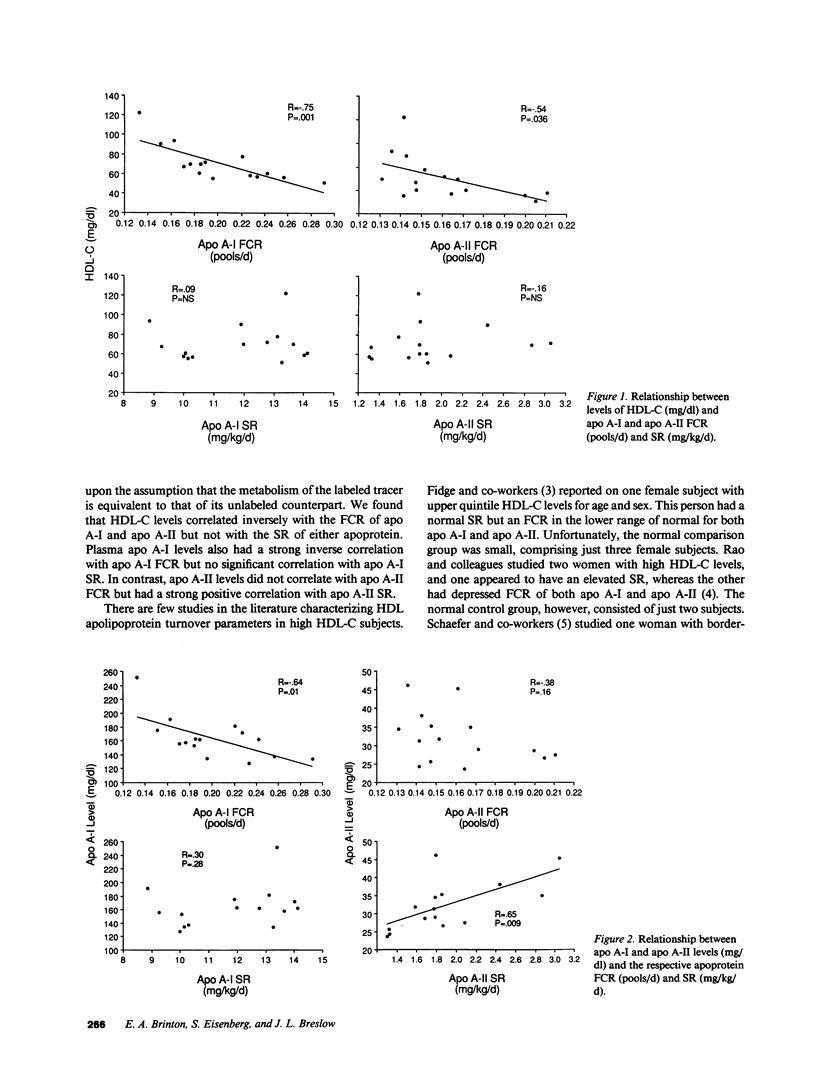
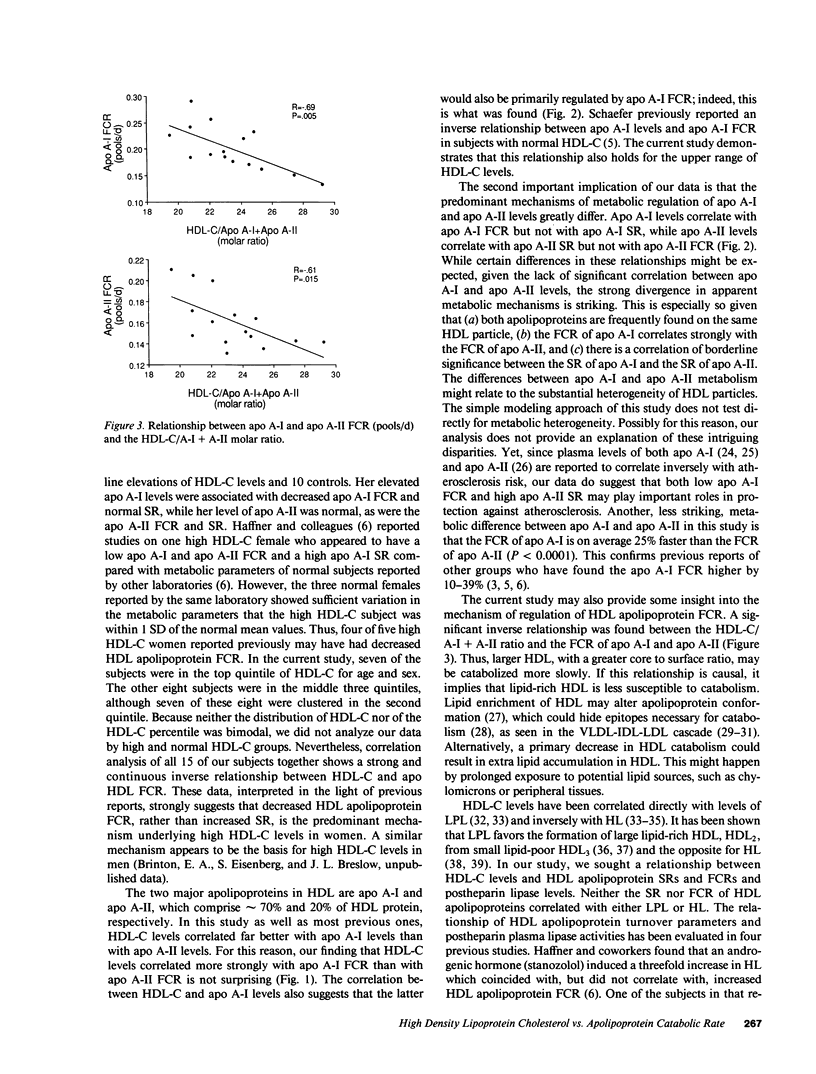
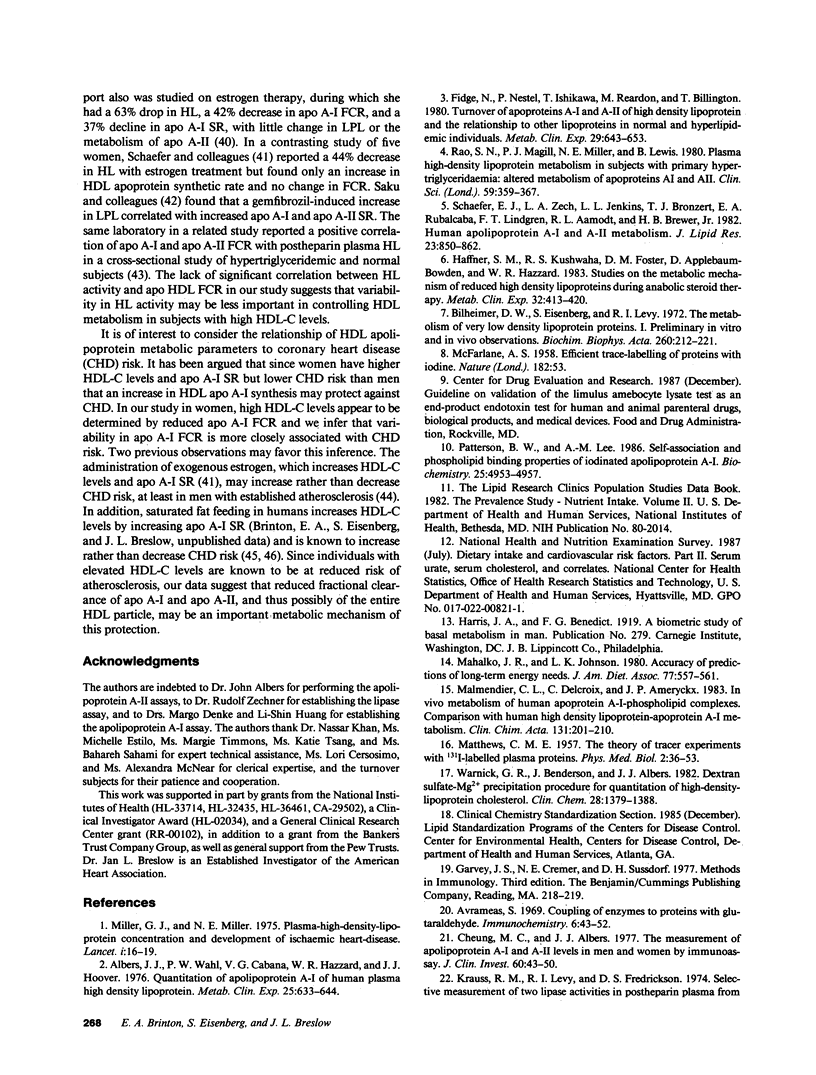
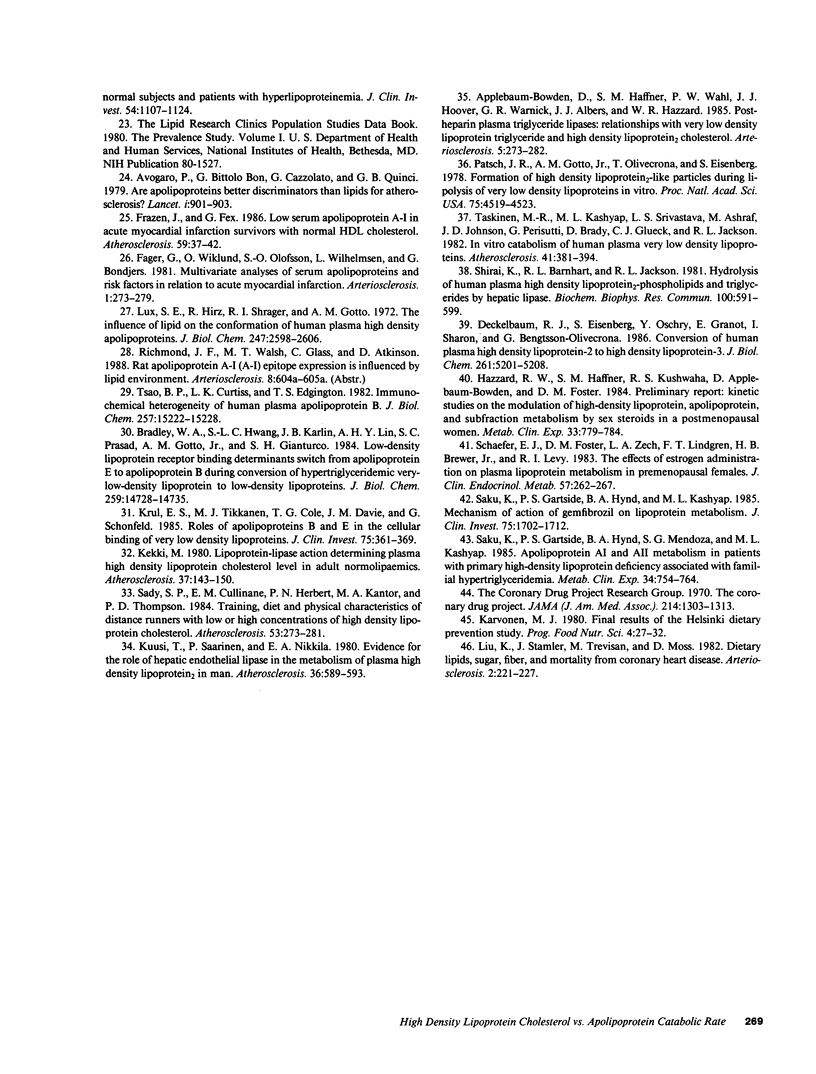
Selected References
These references are in PubMed. This may not be the complete list of references from this article.
- Albers J. J., Wahl P. W., Cabana V. G., Hazzard W. R., Hoover J. J. Quantitation of apolipoprotein A-I of human plasma high density lipoprotein. Metabolism. 1976 Jun;25(6):633–644. doi: 10.1016/0026-0495(76)90060-3. [DOI] [PubMed] [Google Scholar]
- Applebaum-Bowden D., Haffner S. M., Wahl P. W., Hoover J. J., Warnick G. R., Albers J. J., Hazzard W. R. Postheparin plasma triglyceride lipases. Relationships with very low density lipoprotein triglyceride and high density lipoprotein2 cholesterol. Arteriosclerosis. 1985 May-Jun;5(3):273–282. doi: 10.1161/01.atv.5.3.273. [DOI] [PubMed] [Google Scholar]
- Avogaro P., Bon G. B., Cazzolato G., Quinci G. B. Are apolipoproteins better discriminators than lipids for atherosclerosis? Lancet. 1979 Apr 28;1(8122):901–903. doi: 10.1016/s0140-6736(79)91375-8. [DOI] [PubMed] [Google Scholar]
- Avrameas S. Coupling of enzymes to proteins with glutaraldehyde. Use of the conjugates for the detection of antigens and antibodies. Immunochemistry. 1969 Jan;6(1):43–52. doi: 10.1016/0019-2791(69)90177-3. [DOI] [PubMed] [Google Scholar]
- Bilheimer D. W., Eisenberg S., Levy R. I. The metabolism of very low density lipoprotein proteins. I. Preliminary in vitro and in vivo observations. Biochim Biophys Acta. 1972 Feb 21;260(2):212–221. doi: 10.1016/0005-2760(72)90034-3. [DOI] [PubMed] [Google Scholar]
- Bradley W. A., Hwang S. L., Karlin J. B., Lin A. H., Prasad S. C., Gotto A. M., Jr, Gianturco S. H. Low-density lipoprotein receptor binding determinants switch from apolipoprotein E to apolipoprotein B during conversion of hypertriglyceridemic very-low-density lipoprotein to low-density lipoproteins. J Biol Chem. 1984 Dec 10;259(23):14728–14735. [PubMed] [Google Scholar]
- Cheung M. C., Albers J. J. The measurement of apolipoprotein A-I and A-II levels in men and women by immunoassay. J Clin Invest. 1977 Jul;60(1):43–50. doi: 10.1172/JCI108767. [DOI] [PMC free article] [PubMed] [Google Scholar]
- Deckelbaum R. J., Eisenberg S., Oschry Y., Granot E., Sharon I., Bengtsson-Olivecrona G. Conversion of human plasma high density lipoprotein-2 to high density lipoprotein-3. Roles of neutral lipid exchange and triglyceride lipases. J Biol Chem. 1986 Apr 15;261(11):5201–5208. [PubMed] [Google Scholar]
- Fager G., Wiklund O., Olofsson S. O., Wilhelmsen L., Bondjers G. Multivariate analyses of serum apolipoproteins and risk factors in relation to acute myocardial infarction. Arteriosclerosis. 1981 Jul-Aug;1(4):273–279. doi: 10.1161/01.atv.1.4.273. [DOI] [PubMed] [Google Scholar]
- Fidge N., Nestel P., Ishikawa T., Reardon M., Billington T. Turnover of apoproteins A-I and A-II of high density lipoprotein and the relationship to other lipoproteins in normal and hyperlipidemic individuals. Metabolism. 1980 Jul;29(7):643–653. doi: 10.1016/0026-0495(80)90109-2. [DOI] [PubMed] [Google Scholar]
- Franzén J., Fex G. Low serum apolipoprotein A-I in acute myocardial infarction survivors with normal HDL cholesterol. Atherosclerosis. 1986 Jan;59(1):37–42. doi: 10.1016/0021-9150(86)90030-4. [DOI] [PubMed] [Google Scholar]
- Haffner S. M., Kushwaha R. S., Foster D. M., Applebaum-Bowden D., Hazzard W. R. Studies on the metabolic mechanism of reduced high density lipoproteins during anabolic steroid therapy. Metabolism. 1983 Apr;32(4):413–420. doi: 10.1016/0026-0495(83)90052-5. [DOI] [PubMed] [Google Scholar]
- Hazzard W. R., Haffner S. M., Kushwaha R. S., Applebaum-Bowden D., Foster D. M. Preliminary report: kinetic studies on the modulation of high-density lipoprotein, apolipoprotein, and subfraction metabolism by sex steroids in a postmenopausal woman. Metabolism. 1984 Sep;33(9):779–784. doi: 10.1016/0026-0495(84)90102-1. [DOI] [PubMed] [Google Scholar]
- Karvonen M. J. Final results of the Helsinki Dietary Prevention Study. Prog Food Nutr Sci. 1980;4(5):27–32. [PubMed] [Google Scholar]
- Kekki M. Lipoprotein-lipase action determining plasma high density lipoprotein cholesterol level in adult normolipaemics. Atherosclerosis. 1980 Sep;37(1):143–150. doi: 10.1016/0021-9150(80)90102-1. [DOI] [PubMed] [Google Scholar]
- Krauss R. M., Levy R. I., Fredrickson D. S. Selective measurement of two lipase activities in postheparin plasma from normal subjects and patients with hyperlipoproteinemia. J Clin Invest. 1974 Nov;54(5):1107–1124. doi: 10.1172/JCI107855. [DOI] [PMC free article] [PubMed] [Google Scholar]
- Krul E. S., Tikkanen M. J., Cole T. G., Davie J. M., Schonfeld G. Roles of apolipoproteins B and E in the cellular binding of very low density lipoproteins. J Clin Invest. 1985 Feb;75(2):361–369. doi: 10.1172/JCI111708. [DOI] [PMC free article] [PubMed] [Google Scholar]
- Kuusi T., Saarinen P., Nikkilä E. A. Evidence for the role of hepatic endothelial lipase in the metabolism of plasma high density lipoprotein2 in man. Atherosclerosis. 1980 Aug;36(4):589–593. doi: 10.1016/0021-9150(80)90251-8. [DOI] [PubMed] [Google Scholar]
- Liu K., Stamler J., Trevisan M., Moss D. Dietary lipids, sugar, fiber and mortality from coronary heart disease. Bivariate analysis of international data. Arteriosclerosis. 1982 May-Jun;2(3):221–227. doi: 10.1161/01.atv.2.3.221. [DOI] [PubMed] [Google Scholar]
- Lux S. E., Hirz R., Shrager R. I., Gotto A. M. The influence of lipid on the conformation of human plasma high density apolipoproteins. J Biol Chem. 1972 Apr 25;247(8):2598–2606. [PubMed] [Google Scholar]
- MATTHEWS C. M. The theory of tracer experiments with 131I-labelled plasma proteins. Phys Med Biol. 1957 Jul;2(1):36–53. doi: 10.1088/0031-9155/2/1/305. [DOI] [PubMed] [Google Scholar]
- Mahalko J. R., Johnson L. K. Accuracy of predictions of long-term energy needs. J Am Diet Assoc. 1980 Nov;77(5):557–561. [PubMed] [Google Scholar]
- Malmendier C. L., Delcroix C., Ameryckx J. P. In vivo metabolism of human apoprotein A-I-phospholipid complexes. Comparison with human high density lipoprotein-apoprotein A-I metabolism. Clin Chim Acta. 1983 Jul 15;131(3):201–210. doi: 10.1016/0009-8981(83)90089-x. [DOI] [PubMed] [Google Scholar]
- Miller G. J., Miller N. E. Plasma-high-density-lipoprotein concentration and development of ischaemic heart-disease. Lancet. 1975 Jan 4;1(7897):16–19. doi: 10.1016/s0140-6736(75)92376-4. [DOI] [PubMed] [Google Scholar]
- Patsch J. R., Gotto A. M., Jr, Olivercrona T., Eisenberg S. Formation of high density lipoprotein2-like particles during lipolysis of very low density lipoproteins in vitro. Proc Natl Acad Sci U S A. 1978 Sep;75(9):4519–4523. doi: 10.1073/pnas.75.9.4519. [DOI] [PMC free article] [PubMed] [Google Scholar]
- Patterson B. W., Lee A. M. Self-association and phospholipid binding properties of iodinated apolipoprotein A-I. Biochemistry. 1986 Aug 26;25(17):4953–4957. doi: 10.1021/bi00365a035. [DOI] [PubMed] [Google Scholar]
- Rao S. N., Magill P. J., Miller N. E., Lewis B. Plasma high-density lipoprotein metabolism in subjects with primary hypertriglyceridaemia: altered metabolism of apoproteins AI and AII. Clin Sci (Lond) 1980 Nov;59(5):359–367. doi: 10.1042/cs0590359. [DOI] [PubMed] [Google Scholar]
- Sady S. P., Cullinane E. M., Herbert P. N., Kantor M. A., Thompson P. D. Training, diet and physical characteristics of distance runners with low or high concentrations of high density lipoprotein cholesterol. Atherosclerosis. 1984 Dec;53(3):273–281. doi: 10.1016/0021-9150(84)90128-x. [DOI] [PubMed] [Google Scholar]
- Saku K., Gartside P. S., Hynd B. A., Kashyap M. L. Mechanism of action of gemfibrozil on lipoprotein metabolism. J Clin Invest. 1985 May;75(5):1702–1712. doi: 10.1172/JCI111879. [DOI] [PMC free article] [PubMed] [Google Scholar]
- Saku K., Gartside P. S., Hynd B. A., Mendoza S. G., Kashyap M. L. Apolipoprotein AI and AII metabolism in patients with primary high-density lipoprotein deficiency associated with familial hypertriglyceridemia. Metabolism. 1985 Aug;34(8):754–764. doi: 10.1016/0026-0495(85)90027-7. [DOI] [PubMed] [Google Scholar]
- Schaefer E. J., Foster D. M., Zech L. A., Lindgren F. T., Brewer H. B., Jr, Levy R. I. The effects of estrogen administration on plasma lipoprotein metabolism in premenopausal females. J Clin Endocrinol Metab. 1983 Aug;57(2):262–267. doi: 10.1210/jcem-57-2-262. [DOI] [PubMed] [Google Scholar]
- Schaefer E. J., Zech L. A., Jenkins L. L., Bronzert T. J., Rubalcaba E. A., Lindgren F. T., Aamodt R. L., Brewer H. B., Jr Human apolipoprotein A-I and A-II metabolism. J Lipid Res. 1982 Aug;23(6):850–862. [PubMed] [Google Scholar]
- Shirai K., Barnhart R. L., Jackson R. L. Hydrolysis of human plasma high density lipoprotein 2- phospholipids and triglycerides by hepatic lipase. Biochem Biophys Res Commun. 1981 May 29;100(2):591–599. doi: 10.1016/s0006-291x(81)80217-3. [DOI] [PubMed] [Google Scholar]
- Taskinen M. R., Kashyap M. L., Srivastava L. S., Ashraf M., Johnson J. D., Perisutti G., Brady D., Glueck C. J., Jackson R. L. In vitro catabolism of human plasma very low density lipoproteins. Effects of VLDL concentration on the interconversion of high density lipoprotein subfractions. Atherosclerosis. 1982 Feb;41(2-3):381–394. doi: 10.1016/0021-9150(82)90202-7. [DOI] [PubMed] [Google Scholar]
- Tsao B. P., Curtiss L. K., Edgington T. S. Immunochemical heterogeneity of human plasma apolipoprotein B. II. Expression of apolipoprotein B epitopes on native lipoproteins. J Biol Chem. 1982 Dec 25;257(24):15222–15228. [PubMed] [Google Scholar]
- Warnick G. R., Benderson J., Albers J. J. Dextran sulfate-Mg2+ precipitation procedure for quantitation of high-density-lipoprotein cholesterol. Clin Chem. 1982 Jun;28(6):1379–1388. [PubMed] [Google Scholar]


